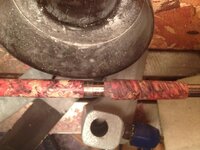MI Hillbilly
Member
I recently turned a box elder burl blank purchased years ago. Sanded up to 2000G followed by white synthetic steel wool. Applied Wood Turners finish and was at first very pleased. But soon noticed a haze on the back half, as if I left a ton of sanding dust. Sanded finish off, and haze got worse. Tried a little BLO with little success. More sanding and it looks horrible now. Under magnification it looks like hundreds of tiny pockets holding dust, but none of it wipes off. Is that possible? I have turned maybe a dozen pens and have not seen this issue before. This is my first stabilized burl. The photo shows before the sanding made things worse.
Thanks,
Scott
Thanks,
Scott

